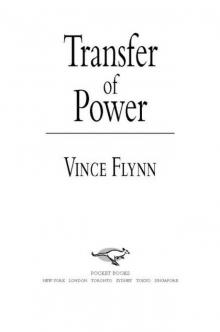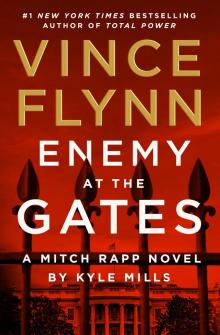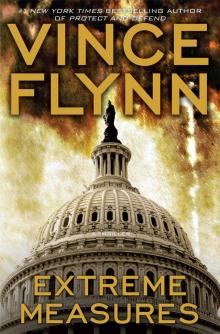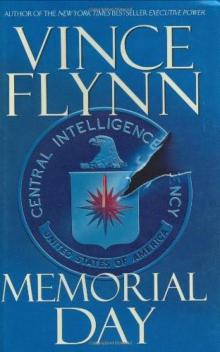- Home
- Vince Flynn
Mitch Rapp 05 - Memorial Day Page 40
Mitch Rapp 05 - Memorial Day Read online
Page 40
“That’s it?” said a shocked Rapp. “That’s our last and best option?”
Reimer didn’t answer right away. “There is one other option, but it has never been fully studied. I don’t think the president would ever authorize it. I know the Pentagon would flat out say no.”
“Why?”
“Because it involves destroying a multibillion-dollar government facility.”
One of the SEALs in desert fatigues came jogging down the dock toward Rapp. “What facility?” asked Rapp.
“Mitch, that’s the president on the other line. I’m going to have to call you back.”
“Don’t…” The line went dead and Rapp cursed.
“Mr. Rapp?”
It was the SEAL who was now standing next to the boat. Rapp let out a long sigh and said, “Yes?”
“Lieutenant Troy Mathews.” The officer stuck out his hand. “General Flood told me to keep you in the loop.”
He shook the officer’s hand. “What’s the status with this thing?” Rapp pointed at the cooler. The two men in space suits were moving a device around the outside of the cooler, pausing every few feet and then moving on.
“That’s a portable X-ray machine. They’re snapping some photos for us so we know what’s inside.”
“Lieutenant,” one of the men in the space suits yelled. “I’m counting six separate firing systems.”
“Six?” the officer asked in a shocked voice.
“Yes, and I think they used plastique for a molded charge. It’s covered with at least two dozen blasting caps.”
“Six firing systems? You’ve got to be shitting me.” Mathews looked toward the parking lot and shouted, “Mike, I need the drill and the fiber-optic camera right away.”
Rapp found none of this comforting. “What’s going on?”
“I’m not sure.” The lieutenant started rolling up his sleeves as he climbed in the boat.
As the lieutenant stepped over the dead bodies Rapp asked, “How long is it going to take you to defuse this bad boy?”
“It all depends on how they’re wired, but I can tell you it isn’t going to be a cakewalk.”
Rapp watched as one of the lieutenant’s men ran down the ramp and into the water, where he handed over a cordless drill and a black bag. A hole was carefully drilled through the top of the cooler, and then the pencil-thin camera head was delicately inserted. The lieutenant knelt down over the cooler and watched the small TV screen as his men took several minutes to try and glimpse as much as possible.
Finally, they pulled the camera out and one of them said, “No trip wires, sir. I think it’s safe to open.”
The lieutenant placed both hands on the top of the cooler and slowly lifted the lid. Rapp stood behind him looking down into the jumbled mass of wires and counted the six separate sets of red numbers. They had fifty-three minutes until the bomb blew.
Rapp swore and then said, “Lieutenant, I need a no bullshit assessment. Can you and your team disarm this thing in less than fifty-three minutes?”
The lieutenant studied the wiring, looking at it from the left and then the right. “I’m not sure.”
“Well, I’m not sure isn’t going to cut it. You see any altimeter in there, or anything else that would preclude us from putting the device on a helicopter, and getting it farther away from the city?”
“No.” Mathews looked at his two men in the space suits. “Guys?”
They both shook their heads.
Another minute ticked off on all six screens and it was Mathews who swore this time.
They’d never make it to the ocean in time. Rapp’s hands were suddenly covered in sweat. “Lieutenant Mathews, this is what we’re going to do. I want your men to place this cooler in the back of that blue-and-white helicopter sitting in the parking lot.”
“I’m going to have to call the Pentagon for an okay on that.”
In a very calm, but firm voice, Rapp said, “Lieutenant, we don’t have time to argue. While your men are putting the device on the helicopter, you are going to assess your chances of defusing it, and I’m,” Rapp held up his phone, “going to call the president and General Flood. If you can’t tell me with absolute certainty that you can stop this bomb from going off, the most important next step is to get it as far away from the city as possible.”
The lieutenant stared down at the jumble of multicolored wires and then nodded. “Okay…it sounds like a reasonable precaution.”
“Then let’s move it quickly and carefully.”
“Mike…Joe,” Mathews yelled. “Bring down the lead blankets. We’re going to move it.”
Rapp got off the boat and started walking down the dock. He dialed a number and put his phone up against his ear. He was going to call the president, but not just yet. There was one other person he needed to talk to first.
The rope that held the cooler in place was cut, and with Lieutenant Mathews supervising, a lead blanket was draped over the cooler and it was carried up the boat ramp and placed in the back of the Bell 430 helicopter. Two older members of the Blue Team as well as one of the Search Response Team members climbed in the back of the chopper and studied the device. Then one-by-one the three of them exited the helicopter, shaking their heads.
Rapp watched all this while he stood in front of the helicopter, his phone stuck to his ear. He guessed correctly that the two older members of the Blue Team were both master chiefs. Master chiefs were the backbone of the SEAL Teams, and when it came to explosives they were some of the most knowledgeable people in the world.
Rapp looked at the two pilots who were still in the cockpit of the CIA helicopter. He held up his right index finger and began twirling it in the air. The pilots nodded and started flipping switches and checking displays. Rapp’s mind was already made up. Every second was going to count, and he wasn’t going to sit around wasting a single one of them.
He began walking toward the helicopter and said into the phone, “So one of your scientists thought this up?”
“Yes,” answered Reimer.
“And you think it’ll work?”
“I know it’ll work. We’ve run all the calculations.”
The engines on the helicopter fired up and a second later the rotors began turning. “Paul, you get all the facts you need to convince the president. I’ll call you back in a minute when I’m in the air.”
Rapp didn’t have to go find Lieutenant Mathews because he was already on his way over. “I need an answer. Can you do it or not?”
“My chiefs say we’ve got a fifty-fifty shot at best.”
“Not good enough,” said Rapp, who immediately turned away from the lieutenant and toward the helicopter.
“What did the president say?”
“He said if you can’t guarantee success, he wants this device as far away from the capital as possible.” Rapp hadn’t spoken to the president, but he was sure that at least on this, they would share the same opinion.
Mathews followed Rapp. “Where are you taking it?”
“I’m not sure just yet,” Rapp lied. He got in the back of the helicopter, closed the door, and asked the pilots, “What’s the top speed of this baby?”
“She’s rated for one hundred and sixty miles per hour, but at that speed we can only stay up for approximately one hundred miles, depending on wind conditions.”
“We’re not going that far. Okay, let’s get the hell out of here. Head due west as fast as you can and as low as you dare. Once we clear the city by at least ten miles we’ll start heading north. I’ll give you an exact heading in a few minutes.”
Rapp sat down, and as the helicopter lifted off the ground, he did the math in his head. They had to go approximately sixty miles. At top speed the helicopter would cover 2.66 miles every minute. That meant it would take less than thirty minutes, not counting takeoff and landing, to get there. He rounded it up to thirty-five just to be safe, and then moved the heavy lead blanket and lifted the lid to the cooler. The closest LED told him the bomb would de
tonate in forty-six minutes. That wouldn’t give him much time to handle the rest but it was doable. Rapp set the timer on his watch and covered the cooler back up with the blanket.
His phone rang and he answered it instantly. “Yep.”
“Are you ready?” It was Reimer.
“Yeah, we’re already in the air.”
“I’ll patch us through.”
There were a couple of clicks on the line and then Rapp heard the president’s voice. “Mitch?”
Rapp leaned his head against the leather headrest. “Yes, Mr. President.”
“Good work today.”
Rapp was caught slightly off guard. For some reason he was expecting to get his ass chewed out. “Thank you, sir.”
“Paul tells me that our technical people aren’t sure they can stop this thing from going off. Is that what you’re hearing?”
“Yes, sir. I was told defusing it was a fifty-fifty proposition at best.”
“How much time do we have?”
Rapp looked at his watch. “Forty-five minutes, sir.”
Reimer quickly interjected, “That’s not enough time to take it out to sea, Mr. President.”
“Then what do you propose we do?”
“We have two options, sir. We can dump it in the Chesapeake, in which case the immediate fatalities will be limited to the number of boaters in the area, though due to the fact that the bay is not very deep the fallout will be significant. We’d end up with a sizable cloud of radioactive vapor that would spread for hundreds of miles, and since the wind is coming from the east, it would move toward the more populated areas.”
“Could it reach Washington?”
“Possibly.”
“How many fatalities?”
“Initially…probably somewhere around a hundred, but the fallout could drive that number easily above a thousand as cancer rates would skyrocket. It would also take decades for the Chesapeake to rebound, as well as the contaminated surrounding areas that take the brunt of the fallout.”
There was silence. “What’s the second option?”
“The second option, sir, is a bit controversial, but it is also the one that would result in the fewest casualties, and do the least harm to the environment.”
“Let’s hear it, then.”
“Take the bomb by helicopter to Mount Weather and put it inside. Then close the blast doors to limit the fallout.”
Mount Weather was a secure hardened facility built in the 1950s, located fifty-five miles from the White House. It was the main location in the Federal Relocation Arc, a system of just over a hundred shelters in five states designed to house key government employees in the case of a nuclear attack or other emergency.
“Mount Weather!” someone shouted. “I’m at Mount Weather! You can’t bring the damn thing here!”
Rapp recognized the voice as belonging to the attorney general. Rapp pictured the look of panic in the man’s face and smiled. Every cloud had a silver lining.
“Mr. President,” said the Director of Homeland Security, “Mount Weather is the backbone of our emergency command-and-control system. The replacement cost would be staggering…it would be at least several billion dollars.”
“We’re a rich country,” answered Valerie Jones. “We’ll build a new one. Mr. President, you can’t drop this thing in the Chesapeake Bay.”
Rapp was slightly taken aback. He thought this was probably the first time he’d ever agreed with Jones on anything.
“FEMA has offices located on that mountain, sir,” countered Secretary McClellan. He was referring to the Federal Emergency Management Agency. “And the Blue Ridge Mountains are as much a national treasure as the Chesapeake Bay. The Appalachian Trail runs within two miles of the place.”
“I think the FEMA facilities will survive the blast, Mr. President,” Reimer said. “Mount Weather is carved out of the most dense rock on the East Coast, and it has two sets of vaultlike blast doors that are each five feet thick.”
Before Reimer could continue, the conference call broke out into a free-for-all with invective and opinions flying back and forth. All of the sudden Rapp felt really tired. The leather chair was comfortable, and the slight vibration from the helicopter was putting him in a trance. He let out a yawn and almost put his feet up on the cooler but he caught himself at the last second.
Rapp shook his head and looked at his watch. After another moment of listening to the arguing he said, “Mr. President.” The free-for-all continued, so he repeated himself a little more loudly. Again, no one yielded so Rapp yelled, “Everybody shut up! Right now!”
The arguing trickled to a stop, and Rapp said, “Mr. President, you need to make a decision. I’m already in the air with the bomb headed west away from the city. Now, if you want me to dump it in the Chesapeake, then you’d better tell me quick, because I’m going to have to turn around and haul ass back over the city, and hope I can get there in time.”
“You’re already on your way to Mount Weather?” asked a shocked Attorney General Stokes.
“Yes, and quit your whining, I’m the one who’s been baby-sitting this thing for the last hour.”
The president’s voice was calm. “I don’t want to hear anyone else speak unless I ask for their opinion. Mr. Reimer, how far away would we have to get the people at Mount Weather to protect them from the explosion and fallout?”
“Not far at all, sir. Our worst-case blast damage analysis indicates that as long as the main blast doors are closed, the facility will contain all of the blast. There is a slight chance of some venting but it will be minimal.”
“How far?” The president sounded impatient.
“A mile would be sufficient.”
“Mitch, how much time do we have left?”
Rapp looked at his watch. “We’re down to thirty-eight minutes, Mr. President.”
“How long will it take you to get to Mount Weather?”
“Approximately twenty-five minutes.”
“General Flood…your thoughts on this?”
“We do have other facilities, sir, such as Site R, where you are right now.”
“But,” interrupted Secretary McClellan, “Mount Weather is the most important facility in the system.”
“Kendall,” the president snapped, “I’m talking to General Flood right now. When I want your opinion, I’ll ask for it. Now, General, as you were saying.”
“For starters NORAD is the most important facility in the system, and from the Pentagon’s point of view Site R is of greater importance than Mount Weather. Even more appropriate, though, is that there’s a shared opinion among the brass that these bunkers are good for command and control, but if we actually go to war with the Russians, or someday the Chinese, Mount Weather will be taken out in the first salvo with either multiple strikes or one of their big, deep underground megaton bombs.”
“So you’re saying it’s obsolete.”
“Sir, I think it was obsolete about a year after it was completed.”
“How long would it take to evacuate the mountain?”
“I have no idea, but I do know it takes ten minutes to close the blast doors.”
Ten seconds of silence ticked by and then the president said, “I want Mount Weather and the surrounding area evacuated immediately! And, General Flood, I want my cabinet members on the first helicopter out.”
“Yes, sir.”
“And make sure Mitch gets whatever he needs.”
“Thank you, Mr. President,” said Rapp. “General, I’ll call you back in a minute with an exact ETA.”
Rapp closed his phone and poked his head into the cockpit. “You guys know where Mount Weather is?” They both nodded. “Good. Get us there as fast as you can.”
VIRGINIA
Mount Weather is located in the craggy northwest corner of Virginia near the West Virginia border, five miles south of the town of Bluemont, Virginia, on Blue Ridge Mountain Road. The site occupies a mere hundred acres, but can be seen for miles around due to the larg
e communications towers that spike up from the peak of the mountain, one of which is owned and operated by AT&T. Since its inception in the fifties, the facility has been shrouded in deep mystery. Not even Congress gets to look at the annual budget, and over the years the facility has even changed names in an effort to keep its location and purpose a secret. Those names have varied from its first code name, which was High Point, to Crystal Palace, the name for the president’s quarters within the facility, to a long list of mundane names that mean different things to different government agencies. In the end, though, it is most commonly referred to as Mount Weather.
The place is a living, breathing dinosaur of the Cold War. Much like Site R, it was built to survive a nuclear war, back when the bombs were bigger in design, smaller in yield, and significantly less accurate. Fortunately for the people who were intended to occupy the facility in the event of a nuclear war, Mount Weather never got the chance to take its place beside the Siegfried and Maginot lines in history’s trash heap of well-intended, but short-sighted, fixed fortifications. Now it would serve a purpose, though, and in the end become the tomb it was always destined to be.
As they approached the mountain from the east, Rapp could see cars moving down the mountaintop’s switchback road like ants streaming out of an anthill. Four military transport helicopters were also taking off from the small landing strip at the top of the mountain and another helicopter was vacating the helipad by the east portal. The Mount Weather facility had two main roads leading into the underground bunker, one on each side of the mountain. Traffic was moving well down both roads. There were a couple of stragglers still getting in their cars, but the bulk of the people were well clear and already past the mile mark.
Just as General Flood had promised, a pickup truck was waiting for them next to the helipad. It was pointed toward the concrete reinforced tunnel entrance that led into the mountain. Rapp checked his watch. They were down to twelve minutes. He yanked the lead blanket off the cooler and checked the timers. They read 00:12:26. A little less than twelve and a half minutes.
Reimer had informed him that the calculations had been based on taking the device into the center of the facility and putting it in an elevator that would drop it down another hundred feet into the bedrock. He promised Rapp there would be plenty of time to accomplish this. Rapp hoped he was right.

 Consent to Kill
Consent to Kill Executive Power
Executive Power Protect and Defend
Protect and Defend Term Limits
Term Limits American Assassin
American Assassin Transfer of Power
Transfer of Power Kill Shot
Kill Shot Vince Flynn Collectors' Edition 2
Vince Flynn Collectors' Edition 2 Enemy at the Gates
Enemy at the Gates Extreme Measures
Extreme Measures Enemy of the State
Enemy of the State Act of Treason
Act of Treason Pursuit of Honor
Pursuit of Honor The Survivor
The Survivor Separation of Power
Separation of Power Memorial Day
Memorial Day The Last Man
The Last Man Pursuit of Honor_A Thriller
Pursuit of Honor_A Thriller Mitch Rapp 13 - The Last Man
Mitch Rapp 13 - The Last Man Consent to Kill:
Consent to Kill: Red War
Red War Mitch Rapp 02 - The Third Option
Mitch Rapp 02 - The Third Option Mitch Rapp 05 - Memorial Day
Mitch Rapp 05 - Memorial Day Mitch Rapp 11 - American Assassin
Mitch Rapp 11 - American Assassin Mitch Rapp 14 - The Survivor
Mitch Rapp 14 - The Survivor Mitch Rapp 06 - Consent to Kill
Mitch Rapp 06 - Consent to Kill Term Limits mr-1
Term Limits mr-1 The Last Man mr-13
The Last Man mr-13 Memorial Day mr-5
Memorial Day mr-5 Order to Kill
Order to Kill American Assassin: A Thriller
American Assassin: A Thriller Separation of Power mr-3
Separation of Power mr-3